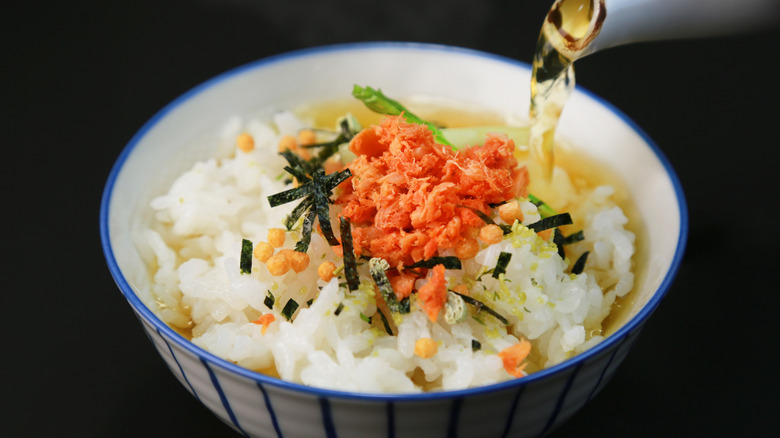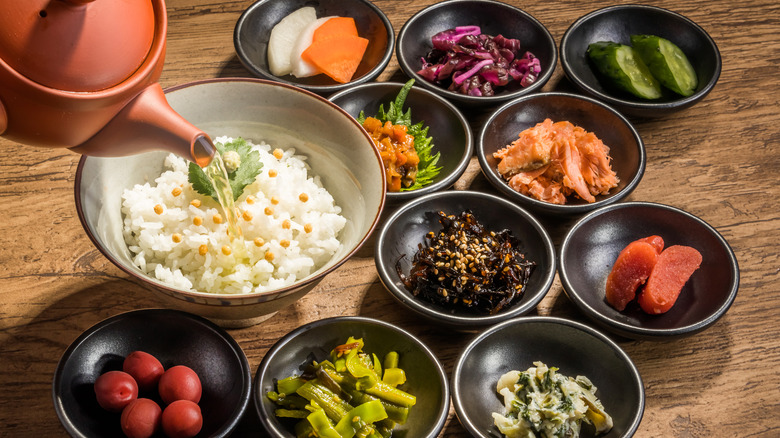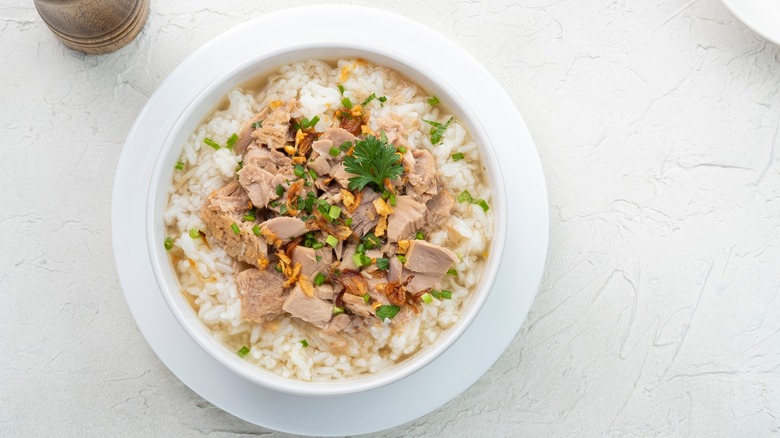Ochazuke: The Soothing Japanese Tea-Over-Rice Dish Perfect For Leftover Tuna
During this time of year, a lot of soup recipes are usually pureed vegetables, muddled with heavy cream and fortified with a thick glug of olive oil. Soups can become a second thought – they must be helped with something more substantial like bread or fat, or tons of seasoning. But soup alone can be filling with the addition of some fish and rice. Japanese ochazuke takes simplicity to the next level — the broth is just tea. And there is something quite savory about green tea and rice, which combines earthy flavors with starchy rice to make something like a deconstructed porridge. Think of ochazuke as a creative way to use your leftover rice and that can of tuna sitting in your pantry. There is nothing fancy or involved about this dish, and it should remain this way in practice.
So what about the seasonings? Well, there are some flavoring agents like dried pickled plum, seaweed, roe, and sesame seeds, but these are optional, according to Just One Cookbook. The main appeal of this tea-over-rice dish is the light, yet roasted aroma which can fill up your stomach on a cold day.
How to make ochazuke
Ochazuke is often prepared in two main ways: with tea or with dashi. The original version of ochazuke used green tea, and it was invented during the Heian period of Imperial Japan (via Recipe Tin Eats). It was a method of utilizing leftover cold rice by adding hot tea to rejuvenate it. Thanks to the accessibility of its ingredients, along with its easy preparation, ochazuke became a staple for the Japanese.
So, if you have some leftover rice in the fridge, and some green tea, you're pretty much set to make ochazuke. As one would steep tea leaves, the rice is steeped in the green tea itself so that it can take on the toasty, herbal flavor of the liquid. Just One Cookbook prepares a pot of green tea, which she pours over a prepared bowl of white rice, topped with fish and other seasonings like crispy rice balls, nori (seaweed), and roe. The other version that uses dashi, which is an essential Japanese soup stock, usually includes soy sauce, mirin, and kelp. The base of dashi can include a variety of ingredients, like this dashi recipe that uses both kombu (kelp) and katsuobushi (dried bonito flakes). The same process is followed for the dashi ochazuke: you pour dashi over a bowl of leftover rice with toppings. Pretty simple, right?
Add tuna for some protein
The most popular fish to add to an ochazuke is salmon; in fact, because it is such a common way of preparing the dish, salmon ochazuke has its own name: sake chazuke, per Taste Atlas. Sake chazuke makes sense because the fat in the salmon greatly compliments the savory, earthy taste of the tea. However, preparing sake chazuke requires the extra step of grilling a salmon fillet. While a Japanese household may have leftover grilled fish lying around, it isn't every day that one has leftover grilled fish in their fridge.
For the sake of simplicity, canned tuna or even tuna steak can be a great option for ochazuke. Coined the "chicken of the sea," flaky canned tuna can create a light, seafood version of our classic chicken noodle soup. Canned tuna can add depth of flavor and a boost of protein to an otherwise light ochazuke. If you'd prefer having a whole fillet of fish, a tuna steak can be steeped, or cooked with the hot tea you pour over the rice. All you have to do is assemble your ochazuke as you would and place the tuna steak on top so that it can be cooked gently.


